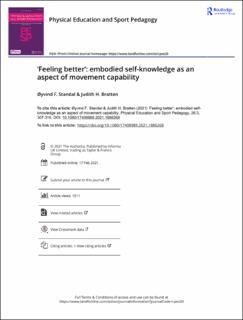| dc.description.abstract | The literature on movement capability critiques the traditional content of physical education (i.e. the what of physical education) and the subject’s reliance on teacher-led methods (i.e. the how of physical education). By re-focusing the content as well as the teaching methods of physical education, the literature on movement capabilities as providing a more student-centered approach to a form of physical education, which is less focused on developing skills and techniques in sporting activities. One important aspect of movement capability is to develop the students’ bodily awareness of their own way of moving. However, our contention is that the focus on students’ bodily awareness this is done in the service of improving specific movements. Purpose In this paper, we want to explore how embodied self-knowledge itself can be considered a movement capability. More specifically, the question guiding this article is: What is there to learn about oneself as a mover in physical education, when one moves without aiming to perfect a specific movement? Method The paper draws on analyses from an auto-ethnographic study performed by one of the authors [Bratten, J. H. (2017). Aktiviteter med lav puls og liten kraft i kroppsøvingsog breddeidrettsfaget. [Activities with low pulse and little excertion]. Master thesis. Oslo Metropolitan University. Oslo, Norway.]. More specifically, she was investigating her role as a teacher in a specific course unit that she had developed, called ‘Activities with low pulse and little exertion.’ This content, consisting of lessons given over a period of 5–8 weeks, is based on traditionally eastern forms of activity like yoga and Qi-gong, where the aim is to move through certain poses with attention directed inwardly and towards breathing. These analyses are combined with theoretical resources from somaesthetics [Shusterman, 2008 Body Consciousness. A Philosophy of Mindfulness and Somaesthetics. Cambrigde: Cambridge University Press; 2012 Thinking Through the Body: Essays in Somaesthetics. Cambridge University Press] in order to elucidate how the course unit can be understood to work with the students’ embodied self-knowledge. Results By employing Shusterman’s fine-grained descriptions of somesthetical movement practices, we are able to highlight that knowing oneself in movement is a valuable end in itself, not only a means to accomplishing specific movements. Our contribution then has been to give an example of how movement capabilities can be conceived of, when movement is understood as a process that can help students to feel better without the need to perform. | |

